HyperEVM is transforming from an unnoticed supporting role into a financial giant, with recent updates propelling it to become a bridge connecting perpetual contracts and the DeFi world.
Authors: Lucas Tcheyan & Will Owens
Translation: Deep Tide TechFlow
HyperEVM is the EVM-compatible general Layer 1 blockchain of Hyperliquid, and it is beginning to show early signs of development.
Although activity on HyperEVM remains relatively subdued compared to HyperCore (Hyperliquid's flagship perpetual contract platform), since its launch in February, HyperEVM has achieved steady growth in trading volume, total value locked (TVL), and application development. Despite the lack of robust tools and direct incentive programs, HyperEVM has made such progress. Upgrades to key infrastructure, a maturing DeFi ecosystem, and increasing speculation about potential airdrops have all fueled the development of HyperEVM.
The recently released CoreWriter update marks a critical moment for the ecosystem. By enabling full write access to HyperCore, CoreWriter will unlock a new class of native applications integrated across both layers, further blurring the lines between the two platforms and allowing HyperEVM to evolve from a Sidecar to the core driving force of Hyperliquid's expanding on-chain financial stack.
Key Points
Development work on HyperEVM is proceeding in an iterative and controlled manner to ensure that its activity does not impact HyperCore. This has posed some resistance for early teams building on the chain, but it has not deterred a significant number of developers from launching applications, with over 175 teams currently building on HyperEVM.
HyperEVM has ranked tenth in TVL among L1 networks. Leading applications are primarily composed of DeFi products, especially lending. This aligns with HyperEVM's goal of unlocking DeFi composability for HyperCore.
HYPE is the native gas token of HyperEVM, with each transaction destroying the base fee and priority fee. So far, transaction fees have accounted for 0.006% of the total supply of HYPE, but if on-chain trading activity rebounds as expected in the coming months, the amount destroyed is likely to continue increasing.
User activity is still catching up to the adoption of HyperCore. As blockchain infrastructure and tools better integrate HyperEVM and HyperCore, the adoption rate of HyperCore is expected to further increase in the coming month.
The latest release of CoreWriter allows smart contracts on HyperEVM to write directly to HyperCore, marking a significant unlocking of the HyperEVM application ecosystem and is expected to drive a surge in application deployments and user activity in the coming months.
Hyperliquid's broader vision is to position HyperEVM as a complementary financial layer to HyperCore. In the future, the goal is to create a vertically integrated DeFi stack that allows trading, lending, treasury, and staking functions to coexist natively across both chains.
HyperEVM Architecture
Hyperliquid has two interrelated but independent platforms: HyperEVM and HyperCore. Among them, HyperCore is more well-known as Hyperliquid's perpetual contract futures platform, featuring an on-chain order book, margin system, and matching engine. Since its launch in 2023, it has dominated the perpetual contract market and has even begun to compete with perpetual contract products from centralized exchanges. HyperEVM is Hyperliquid's EVM-compatible general L1 layer. HyperCore is a newer platform launched on February 18, designed to unlock DeFi composability for HyperCore through integration with general smart contract platforms.
A key distinction here is that HyperCore and HyperEVM are independent chains, but they are both secured by the same HyperBFT consensus mechanism (a combination of proof-of-stake and Byzantine fault tolerance optimized for high throughput and low latency systems) and the same validator set. This allows applications built on HyperEVM to interact directly with HyperCore's spot and perpetual order books.
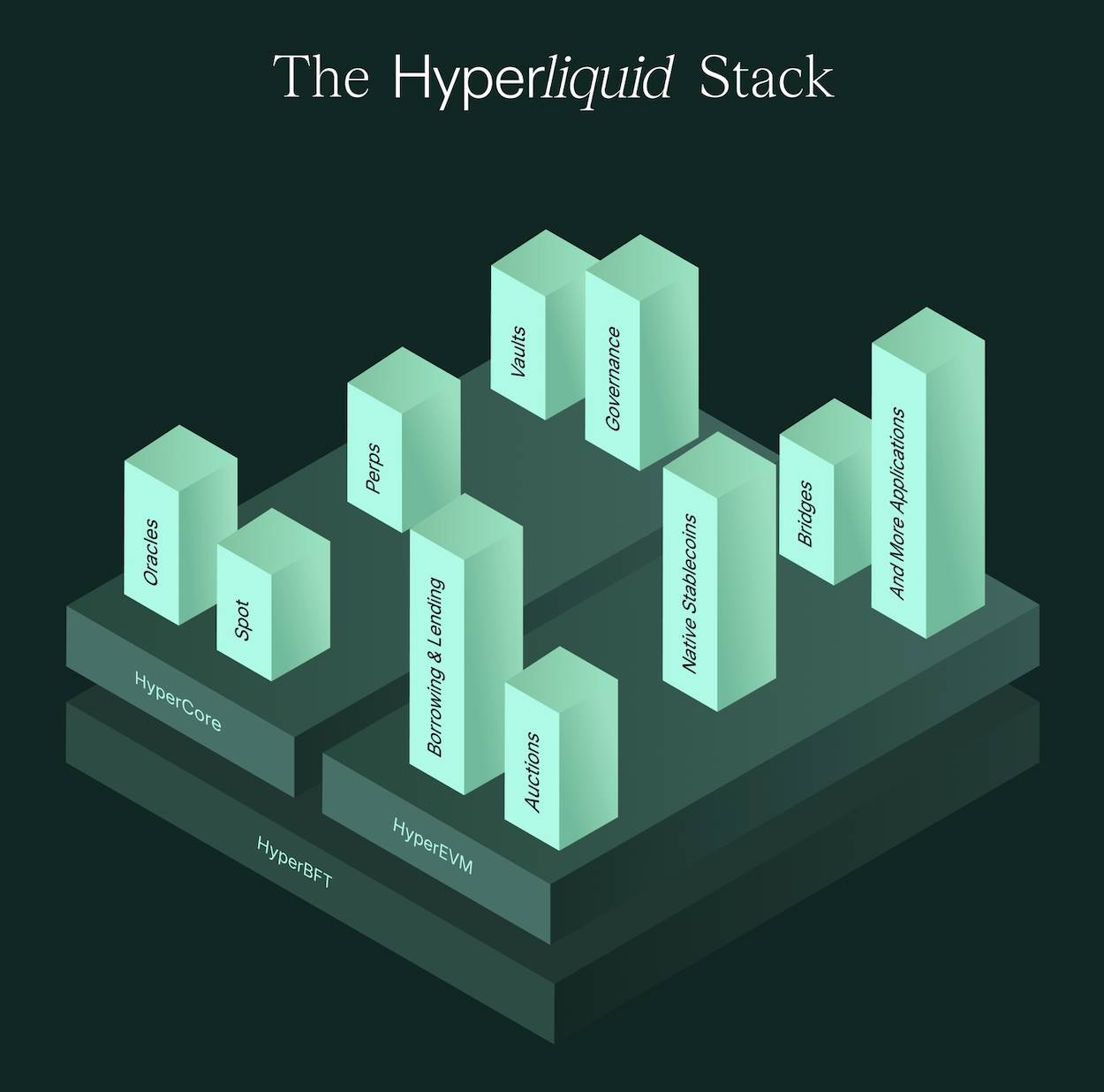
(Source: Hyperliquid Docs)
Consensus and Execution
HyperEVM employs a "dual-block architecture" to address the trade-off between speed and capacity. It processes fast small blocks once per second, with a gas limit of 2 million, allowing regular transfers and transactions to be completed almost instantly. Meanwhile, it processes large blocks once per minute, with a gas limit of 30 million, providing builders with the space to handle heavyweight tasks such as deploying large smart contracts or minting large quantities of NFTs. The chain's block delay is under one second, supporting up to 200,000 orders per second.
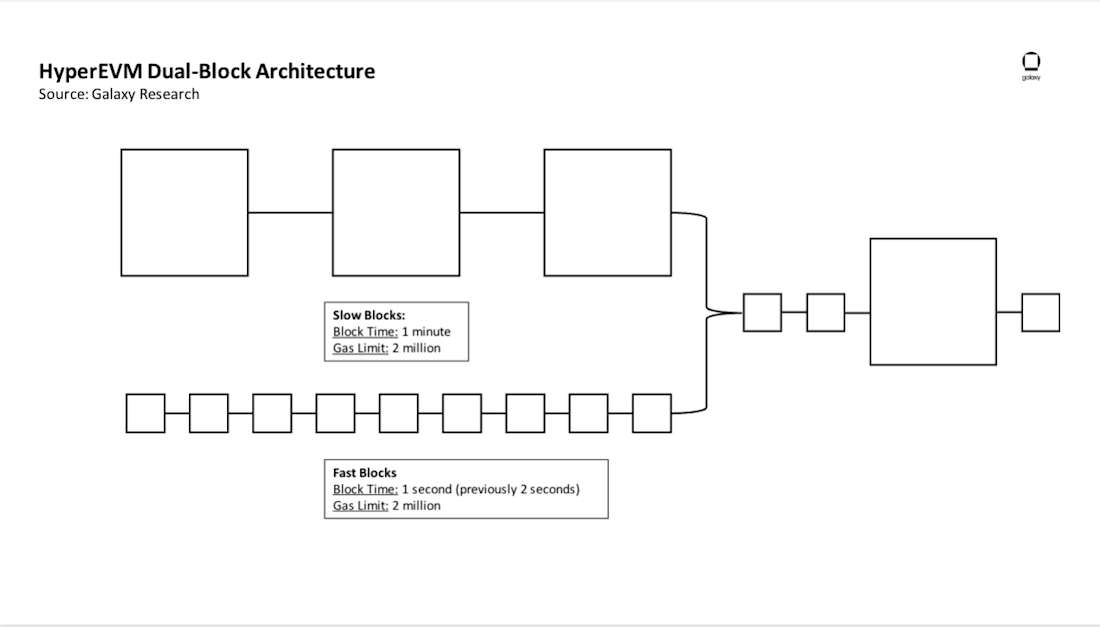
While HyperEVM boasts high throughput and low latency, its transaction fees are consistently higher than those of Ethereum L2 networks, especially during periods of on-chain congestion. The following chart compares the median daily transaction fees of HyperEVM with seven L2 networks.
Notably, HyperEVM fees spiked significantly during peak activity (with each transaction exceeding $0.30).
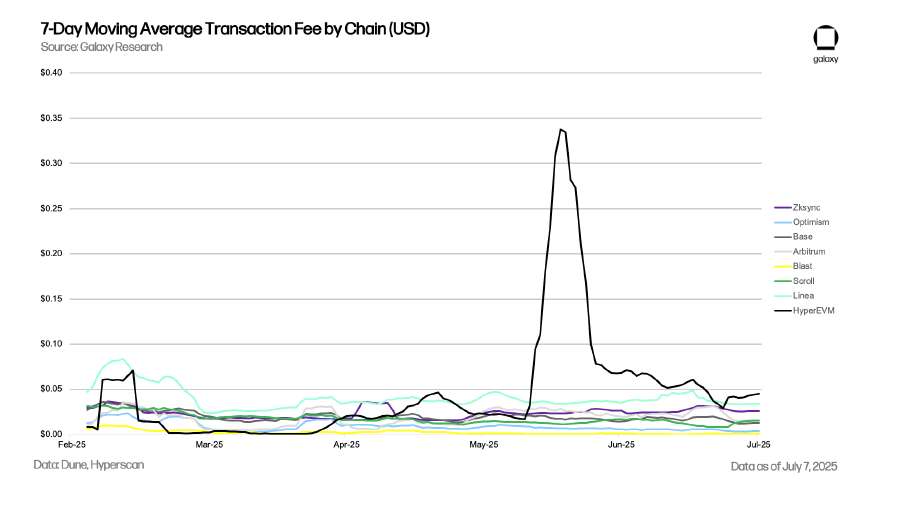
HYPE is the gas token on HyperEVM, which utilizes an improved version of Ethereum's EIP-1559 burn mechanism to destroy base fees and priority fees. The chain is EVM-compatible, allowing teams to easily redeploy EVM smart contracts on HyperEVM. Since its launch, over 55,000 HYPE tokens have been destroyed, accounting for 0.006% of the total supply of HYPE. In contrast, over 367,000 HYPE have been destroyed on the HyperCore platform due to spot trading fees. At the current market price of HYPE at $39.12 per token, this destruction represents over $2.15 million in HYPE destroyed since launch. On May 26, the daily destruction peaked at 5,849 HYPE (approximately $226,000), coinciding with a surge in contract deployments and user activity. As activity on HyperEVM continues to expand, its contribution to the total consumption of HYPE will significantly increase, shifting from marginal consumption to a substantial driver of long-term supply reduction.
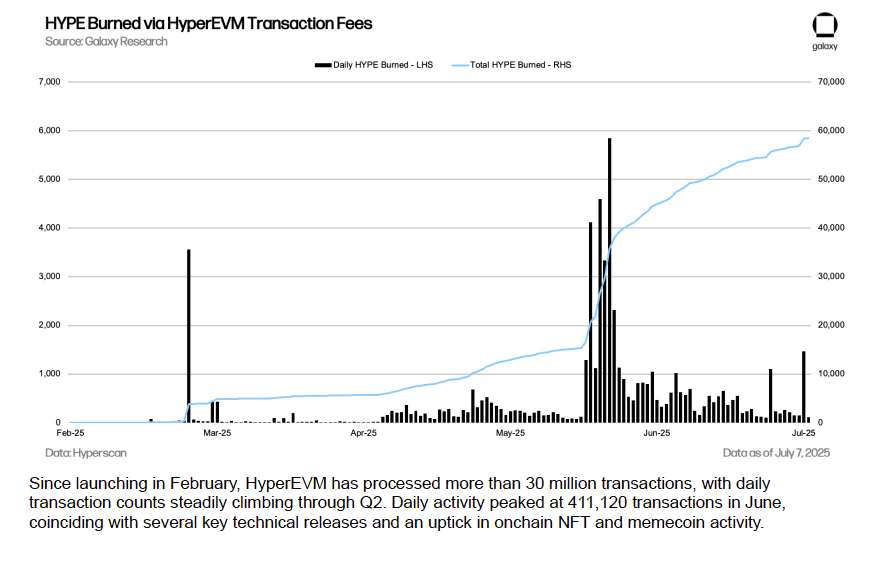
Since its launch in February, HyperEVM has processed over 30 million transactions, with daily transaction volume steadily climbing in the second quarter. In June, daily transaction volume peaked at 411,120, while several key technologies were also released, and on-chain NFT and memecoin trading volumes showed an upward trend.
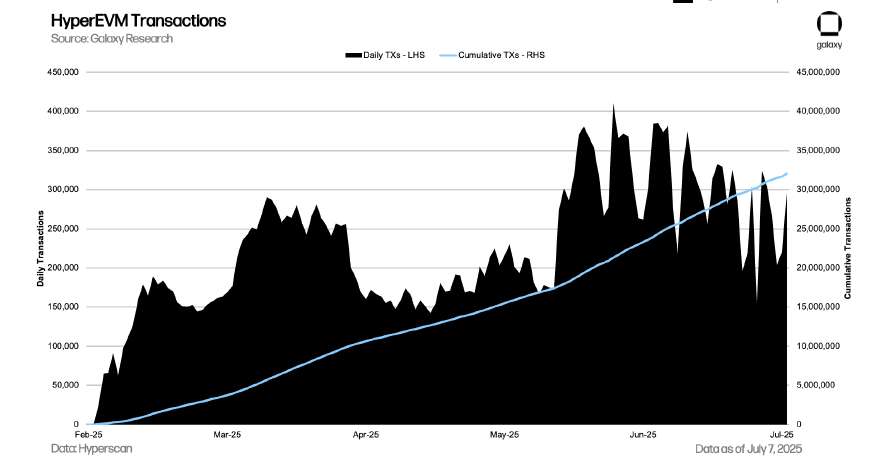
Technical Upgrades
When HyperEVM launched, it only had very basic functionalities, including spot transfers of HYPE with HyperCore and packaged HYPE contracts for DeFi applications. This was a very rudimentary release, as the chain lacked many key features that should ultimately distinguish it from other general Layer-1s, the most notable being integration with HyperCore.
In the release announcement, the team stated that one reason for launching in such a raw state was to ensure that everyone could "access equally and start in a fair competitive environment." Additionally, the gradual rollout strategy allowed them to safely upgrade the system step by step while integrating user feedback in real-time. According to the development team of HyperEVM, the lack of robust tools did create some resistance, but it did not hinder their development progress.
Since launch, the team has implemented several technical updates to HyperEVM, including:
March 25: HyperCore connected with HyperEVM, allowing users to trade any token on one chain from another chain.
April 30: Launched read precompiles, enabling HyperEVM smart contracts to read state from HyperCore.
May 26: Halved the duration of small blocks to 1 second, enhancing HyperEVM's throughput. Improving throughput remains the team's top technical priority, with further reductions in block time expected.
June 26: HyperEVM blocks have been updated to remove the previous sorting of only posted orders to improve integration with HyperCore.
On July 5, HyperEVM was updated with a new precompile called CoreWriter. This allows HyperEVM contracts to write directly to HyperCore, including functionalities such as placing orders, transferring spot assets, managing treasuries, and staking HYPE. This upgrade transforms HyperEVM from a chain that could only read updates from HyperCore to one that can directly update HyperCore's state, marking a significant advancement for HyperEVM's unique capabilities (which will be discussed further below). The team announced the first upgrade of CoreWriter on July 2, and it was officially deployed three days later (mainnet updates are typically deployed on Saturdays).
While CoreWriter represents an important step towards unification between HyperEVM and HyperCore, it also has some limitations. Most notably, write operations performed through CoreWriter are not atomic operations (Note: in multithreaded programming, an operation that is not interrupted by the thread scheduling mechanism; once started, it runs to completion), meaning that smart contracts cannot confirm in a single transaction whether orders or state changes on HyperCore were successful. This asynchronous design is intentional, aimed at minimizing front-running, but it poses challenges for more complex or precision-dependent trading strategies. Therefore, while CoreWriter allows for new types of applications, its early implementations are more suited to use cases that can tolerate asynchronous execution or have a high success rate, such as staking, treasury deposits, and simpler programmatic interactions. Given the complexity of interactions between HyperEVM and HyperCore, the Hyperliquid team will continue to iterate and update, gradually unlocking new features to ensure they do not impact HyperCore's functionality.
HyperEVM's Application Ecosystem
Since its launch, the HyperEVM ecosystem has rapidly developed, with over 175 projects publicly building on its chain, and many more projects being developed in secret. Developers are the core of any emerging ecosystem, and Hyperliquid has attracted a large number of strong developers due to its unique architecture and integration with HyperCore. HyperCore is one of the most liquid on-chain exchanges, with a large user base that can easily migrate to HyperEVM. We have communicated with many teams that previously worked on other chains and are now building on HyperEVM, and they repeatedly emphasize that the decision to migrate stems either from ongoing user demand or from the need for applications to have more liquidity to function properly. Additionally, unlike many other Layer-1 ecosystems, Hyperliquid attracts developers without the need for dedicated incentive/funding programs. The success of HYPE, combined with expectations for future airdrops (which account for 42% of the remaining supply), has proven sufficient to provide adequate incentives.
The total value locked (TVL) in HyperEVM has steadily climbed to the tenth position in the L1 rankings since its launch. The growth in TVL is primarily concentrated in several key protocols (which will be detailed below). Importantly, this growth has occurred without any liquidity mining activities or ecosystem incentives. While most of Hyperliquid's users and trading activity still take place on HyperCore, HyperEVM is now positioning itself as the DeFi settlement layer for the entire stack. With CoreWriter set to unlock write permissions for HyperCore, TVL will shift from passive capital (idle lending) to active capital, trading with real-time perpetual contract markets, treasuries, and order books.
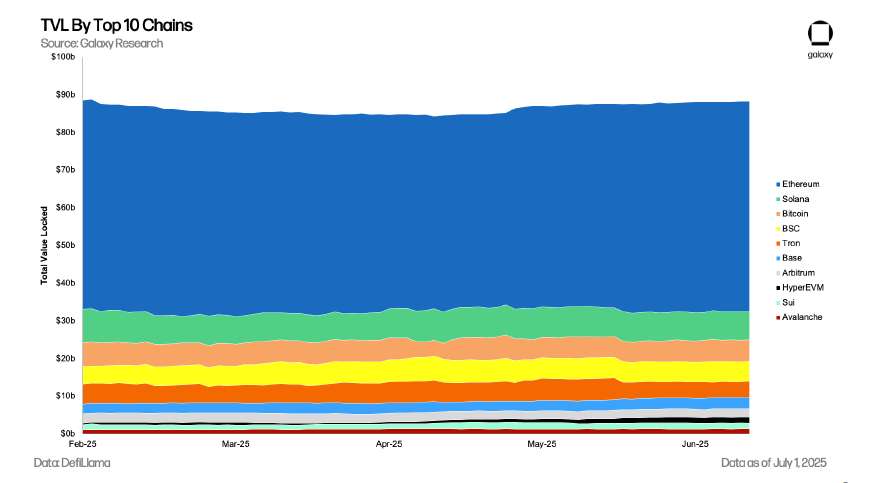
As shown in the chart, the ecosystem's assistance fund holds HYPE tokens (25.79 million) that still exceed the total HYPE tokens on the entire HyperEVM chain (approximately 25 million). This imbalance indicates that HyperEVM is still in its early stages. As on-chain usage increases, we expect more idle funds to migrate to efficient DeFi use cases.
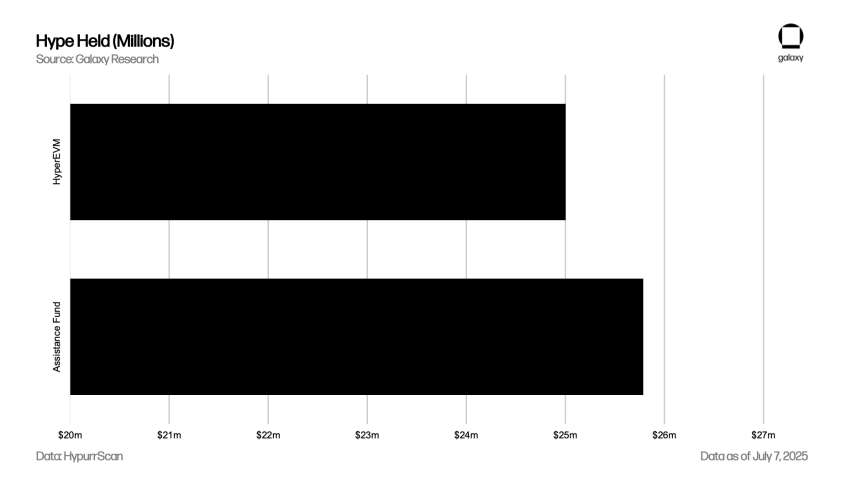
Although HyperEVM went live as early as February, the deployment of smart contracts on HyperEVM did not truly begin until mid-May. This was primarily due to several reasons. At launch, HyperEVM lacked ERC-20 support, a block explorer, or reliable indexing tools, which imposed many limitations on developers. Additionally, the Hyperliquid team provided little advance notice of HyperEVM's launch date, leading many teams to start full development and deployment of contracts only after HyperEVM went live. As core infrastructure and tools (such as cross-VM asset bridges, contract indexing, and verification tools) were gradually released in March and April, the deployment of smart contracts began to accelerate. With the launch of CoreWriter, we expect a further surge in smart contract deployments as applications update their functionalities and products come to market.
Top TVL Ranking Protocols
HyperLend is the project with the highest TVL on HyperEVM, boasting $487 million, and is the primary lending protocol on HyperEVM. It offers many standard lending features, such as core pools that allow for providing or borrowing multiple tokens in a single pool; an efficiency mode that allows users to borrow related assets with higher TVL; and isolated pools that segregate risk to specific token pairs. On June 10, HyperLend announced a focus on integration with HyperCore. With this latest update, position liquidations can now be conducted directly on HyperEVM or through cross-chain execution on HyperCore. This is one of the first significant integrations between HyperEVM and HyperCore, likely aligning with the vision of Hyperliquid's founders when launching HyperEVM. Through the HyperCore integration, HyperLend now offers three different liquidation methods for liquidators. For a complete overview of HyperLend's liquidation processes, please refer to the team's post here. The team has also hinted that they are developing other products utilizing the CoreWriter version, but no details have been disclosed yet.
Felix ranks second with a TVL of $340 million, while also offering a range of on-chain lending products. The application has two core primitives: a collateral debt position market and a "vanilla" lending market. Felix leverages Hyperliquid's EVM compatibility as its backend infrastructure, using Liquity's v2 architecture for its CDP stablecoin feUSD and Morpho's tech stack for its vanilla lending market. In April of this year, Felix announced the launch of USDhl, a fiat-backed stablecoin developed in collaboration with the stablecoin platform M0. According to publicly available on-chain data, since its launch, Felix's stablecoin products have contributed over $100 million in stablecoins to the HyperEVM ecosystem, with the majority ($75 million) coming from feUSD. Felix also plans to integrate liquidation features on HyperCore after the release of CoreWriter.
HypurrFi is the third-largest lending application on Hyperliquid, with a total locked value (TVL) of $318 million. It claims to be Hyperliquid's "debt infrastructure provider." In addition to lending services, HypurrFi offers over-collateralized stablecoin USDXL, a built-in decentralized exchange (DEX), and yield vaults for users to deploy assets. Following the decoupling of USDXL from the US dollar in May, the team has reduced the issuance cap of this stablecoin to $5 million while working to implement a more robust pegging mechanism.
HyperSwap and KittenSwap are the main AMM decentralized exchanges (DEX) on Hyperliquid, ranking fourth and fifth in terms of total locked value (TVL). They draw from common EVM AMM designs and offer standards and concentrated liquidity positions similar to Uniswap. KittenSwap also adopts Curve's ve(3,3) model. The release of CoreWriter will significantly enhance their functionalities, allowing these two DEXs to integrate with the HyperCore order book, enabling users' orders to be routed through either the DEX or the order book for optimal execution.
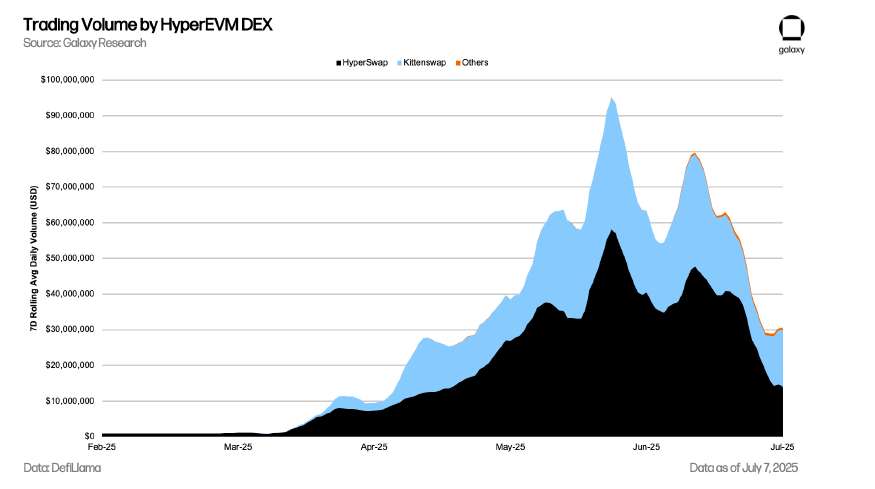
Unit Protocol serves as the asset tokenization layer of the Hyperliquid ecosystem, supporting cross-chain access to mainstream cryptocurrencies like BTC, ETH, and SOL on HyperCore and HyperEVM. Unit operates a decentralized guardian network that issues native spot assets through a "lock-and-mint" system without relying on centralized custodians. As of July 1, Unit has deployed over $100 million in BTC and $13 million in ETH on HyperEVM.
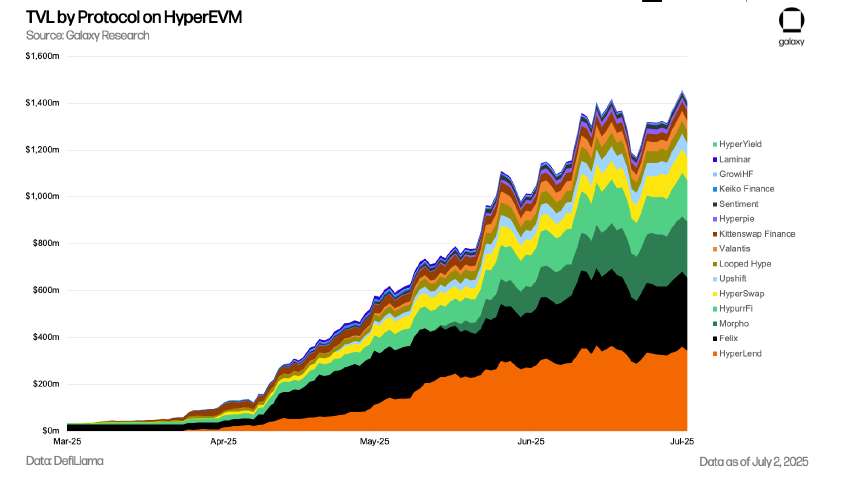
In addition to the examples mentioned above, many teams are developing products that rely on CoreWriter integration. Here are some examples:
Kinetiq is a liquid staking protocol on Hyperliquid that operates on both HyperCore and HyperEVM. It allows users to stake the native HYPE tokens on HyperCore and receive kHYPE (a liquid staking token that can be used in DeFi applications on HyperEVM). Kinetiq employs an oracle-based autonomous validator selection system that dynamically delegates HYPE to the highest-performing validators, optimizing yields and ensuring network security. To facilitate staking operations between HyperEVM and HyperCore, Kinetiq will leverage CoreWriter to provide convenient integration and liquidity for staked assets. Just a few days after the release of CoreWriter, the team announced plans to launch the product on July 15.
Sentiment is a decentralized lending protocol on HyperEVM that allows users to borrow and lend assets with customizable leverage. It enables users to stake assets (such as Kinetiq's kHYPE or other HyperEVM tokens) to borrow stablecoins like USDC at competitive rates, facilitating strategies such as leveraged liquidity mining. Sentiment's smart contracts are set to interact with HyperCore through CoreWriter, allowing real-time access to Hyperliquid's on-chain order book for collateral valuation and liquidation management.
HyperDrive and Hyperwave provide a tokenized version of HLP (a community-owned protocol library that executes market-making and liquidation strategies on HyperCore). The update of CoreWriter will make it easier for these projects to integrate HLP into the evolving DeFi ecosystem of HyperEVM.
Liminal is a delta-neutral yield protocol built on HyperCore. Liminal utilizes Hyperliquid's high-performance trading infrastructure to execute automated, market-neutral strategies and capture funding fees from the perpetual futures market. Its non-custodial design ensures users maintain control over their funds, while institutional accounts leverage Hyperliquid's native proxy system to ensure secure trade execution. The release of CoreWriter will ultimately enable the team to deploy HyperEVM contracts for users to manage positions on HyperCore.
Rysk is a decentralized options trading protocol based on HyperEVM that transforms covered calls into highly liquid, tradable primitives. It allows users to pre-earn yields while enabling advanced options trading within Hyperliquid's DeFi ecosystem. Rysk utilizes the HyperCore API to hedge buyer options flows in real-time and directly on-chain, but the team plans to update the stack to integrate CoreWriter. This will reduce the execution risk of covered call options and provide users with greater transparency. The team is also exploring other options to enable users to build their own custom trading strategies using HyperEVM and CoreWriter, combining options and perpetual options.
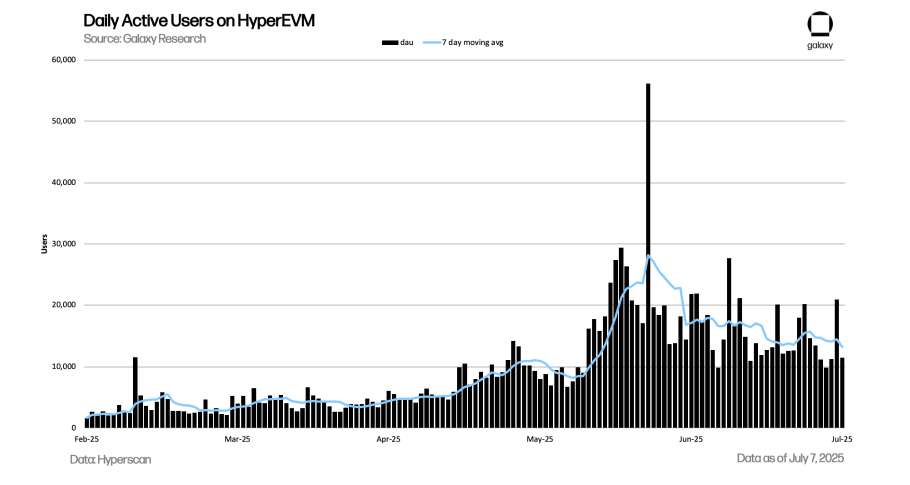
Outlook
With nearly six months since its launch, HyperEVM possesses all the elements to become a general-purpose L1 platform and complements successful perpetual contract platforms. Other emerging L1 platforms require large incentive programs and truly novel applications to attract users and developers, while HyperEVM has built-in access to both, allowing developers to focus on product development and innovation.
Jeff Yan, founder of Hyperliquid, recently stated in a podcast: “(Hyper)EVM is to the entire financial sector what AMM is to the entire trading sector.” While HyperCore is the main building block of the Hyperliquid ecosystem, it alone cannot satisfy all use cases built on perpetual contract exchanges. In the short term, HyperCore may still be the primary trading hub, but we expect that as blockchain performance and tools improve and applications mature, activity on HyperEVM will accelerate over the next year. Through vertical integration of the platform, Hyperliquid aims to create a comprehensive financial ecosystem that provides users with a one-stop service and maintains liquidity stickiness.
The recently released CoreWriter is an important catalyst that will accelerate the development of HyperEVM through comprehensive integration with HyperCore. It will allow applications on HyperEVM to write directly to HyperCore for the first time, enabling seamless interaction between the two environments and unlocking more powerful and coordinated on-chain applications.
In short, CoreWriter represents a significant milestone for HyperEVM, and developers have expressed interest in leveraging this integration to build products that are hard to find elsewhere.
免责声明:本文章仅代表作者个人观点,不代表本平台的立场和观点。本文章仅供信息分享,不构成对任何人的任何投资建议。用户与作者之间的任何争议,与本平台无关。如网页中刊载的文章或图片涉及侵权,请提供相关的权利证明和身份证明发送邮件到support@aicoin.com,本平台相关工作人员将会进行核查。




